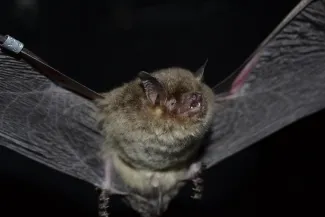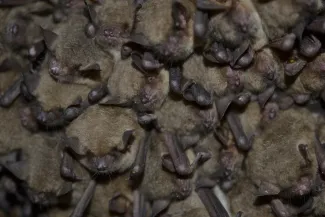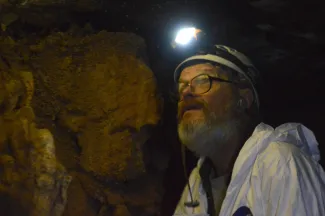The peaceful dusk of late spring and summer signals the evening feeding session of Oklahoma’s 20-plus bat species. Some of these winged mammals choose to hunt their prey of moths, beetles and other flying insects in meadows or wooded areas. Other species prefer foraging over streams and bodies of water. Whether flying low over the ground with gracefully slow and deliberate wing strokes or erratically high above a stream, bats are fascinating to watch.

Bat Habitat
Outdoor enthusiasts hoping to attract bats to their property and witness their nightly emergence have several options.
The first step is to look at the surrounding habitat. In Oklahoma’s forested areas, bats prefer hunting in open woodlands with abundant grasses and forbs growing under the canopy. Our forb-rich prairies provide a similarly diverse insect prey base. On a backyard level, bats can be seen hunting over gardens or wildscapes full of evening pollinator-attracting plants.
After their nightly feeding session, bats seek out daytime roosts. Some species prefer crevices and cavities of trees. Others conceal themselves behind loose bark. Some spend the day in rock piles or caves. Our most common bat, the eastern red bat, hangs behind a leaf in a tall tree.
To restore the required bat foraging habitat, landowners may need to selectively thin forests, or control saplings, vines and other woody plants growing on the forest floor. Prescribed fire is an effective tool for managing the understory growth in forests and also limits woody growth in prairie settings. Fire can also encourage herbaceous plants in both woodlands and grasslands. These herbaceous plants encourage a diverse insect community. When managing forested areas, landowners should choose which trees are removed with care; standing snags or cavity trees may be used for bat roost sites, or even for eastern bluebird nest sites.
These habitat management practices aren’t just for bats; other wildlife species such as the northern bobwhite and many species of songbirds need the same habitat. To make sure all management options are considered, take advantage of the many state and federal agencies dedicated to helping landowners. Contact a Wildlife Department private lands biologist for technical advice or visit a U.S. Department of Agriculture office to learn more about programs that benefit wildlife, such as the Healthy Forest Reserve Program and the Environmental Quality Incentives Program.
If habitat is lacking or out of your management control, consider adding a bat box to the property. These boxes may provide supplemental roost habitat and are primarily used by male bats during the day. Be aware that only seven of Oklahoma’s 24 species of bats will use a bat house. Even so, bat boxes can be used by female bats and their pups should the original maternity colony be excluded from a building or attic.
Boxes can be purchased or built at home. Research has shown roost boxes should be at least 24 inches tall, 13 inches wide and 3 inches deep. Most bats prefer chambers be positioned three-fourths of an inch to 1 inch apart. Be sure the finished bat box is caulked to prevent moisture and is installed in a sunny area at least 15 feet above the ground. Consider hanging the box from a pole or on a building near a garden or water source. Bat boxes can be checked at least once a week in the early morning by shining a flashlight into the house.
This plan from the Organization for Bat Conservation could attract bats to your property and is an excellent beginner woodworking project. Check out “Landscaping for Wildlife: A Guide to the Southern Great Plains” for construction plans for a multi-chambered bat house and additional information about attracting wildlife to your property.
Counting Bats
The nocturnal nature, small size and agile flight of bats create several challenges for the biologists charged with managing bat populations. Monitoring is a key component of that management and requires many partnerships and a little resourcefulness.

During winter months, biologists, members of caving organizations and other volunteers quietly enter caves across the state and conduct counts along a prearranged route. Though it sounds straightforward, getting to the caves can require a demanding hike. And the darkened caverns call for sense of adventure and a lot of ducking. When on a cave’s survey route, observers must be vigilant. Bats can be found most anywhere: clinging to high ceilings, along the wall of a shadowed alcove, or even wedged into tight crevices less than an inch wide. Some bat species prefer spending the winter alone, while others form large clusters that might contain hundreds of individuals.

Winter counts also provide an opportunity to inspect the bats for white-nose syndrome, a disease that affects hibernating bats. Biologists collect samples from select bats across the state by running a small swab over the bat’s forearm and around the muzzle. The swabs are then sent to a New Mexico laboratory, where they join samples from across the nation to be tested for the disease. To date, Oklahoma’s bats are free of white-nose syndrome.
In addition to the 14 bat species that are found in Oklahoma year-round, some bat species are only summer visitors to the state. Because bats are actively using the caves in spring and summer, and colonies of female bats with pups are especially vulnerable to disturbance, researchers and biologists typically switch to techniques that do not require entering the caves for estimating the summer bat population.
One method involves biologists setting up outside cave entrances at night and using night-vision scopes and infrared lights to quietly count bats as they emerge from the cave to forage on insects. With the help of thermal and infrared videography, biologists also record footage of bats emerging from the caves for the evening feeding session. The videos are then analyzed and compared to footage taken during previous years. Because the recordings are consistently taken from the same location and time of year, biologists can observe population trends and make better-informed management decisions. To get an estimate of some summer colonies of the endangered gray bat, biologists enter the caves in the winter after the bats have migrated out of state and measure the large guano pile deposited during the summer.
In addition, biologists at the Ozark Plateau National Wildlife Refuge in northeastern Oklahoma have adopted an auditory monitoring program in the summer. Using state-of-the-art bat detectors that can register ultrasonic echolocation calls, biologists can see real-time sonograms of the bat calls. Identification is possible because bat species often call at different frequencies and have different sonogram patterns. These biologists are also documenting how bats use the area by driving through the refuge with an external microphone attached to the vehicle roof with an extension cable connected to the bat detector inside the vehicle. With this technology, biologists are able to record the exact location of every detected bat call. These mobile acoustic surveys reveal important seasonal habitats and bat movements across the refuge.
With so many partnerships and bat-related projects taking place in Oklahoma, a specialized group was formed to help facilitate the flow of information to partners, scientific cooperators, interested parties, stakeholders and user groups on bat and cave management, bat research and bat diseases. Members of this Oklahoma Bat Coordinating Team have direct bat and cave management responsibilities across the state and meet regularly to provide project updates, discuss bat and cave issues, and share their expertise.